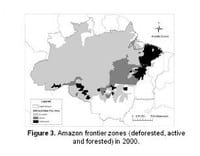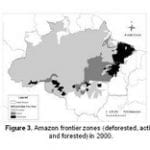



The Amazon is the largest remaining tropical forest and protects the world biggest biodiversity .
This region is considered vitally important both to global environmental services and to Brazil’s development prospects. Frontier expansion in the Brazilian Amazon is a classic example of the trade-off between environmental conservation and economic development. Deforestation is mostly driven by market demand, especially for timber, soybeans and beef. However, while 17.7 thousand km2 per year have been deforested to meet this demand since 1990, poverty remains severe. In this study, we explore regional patterns in deforestation and poverty, using spatial analyses and multivariate models to test the hypothesis that frontier development has followed a boom-bust pattern. Specifically, we test for a quadratic relationship between cumulative deforestation and extreme poverty rates (individuals with per capita income less than US$1/day) in 408 municipalities (3.7 million square kilometers). In multivariate analyses, we include biophysical, demographic, and access factors that have been identified as key constraints and drivers of both deforestation and development. Even after controlling for these factors, our analyses consistently and robustly show a boom bust pattern. In terms of monetary poverty, heavily deforested municipalities are no better off than forested municipalities, while they clearly are left with less natural capital. From a long-run and local perspective, deforestation does not appear to bring any net gain. From a short-run perspective – and certainly from the perspective of agribusiness, ranchers, or the logging industry – deforestation brings an economic boom. Thus, the current paradigm of frontier expansion in the Amazon presents a trade-off between present and future as much as between environment and development.
This post was published on 26 de junho de 2012
O Imazon está contratando estagiário para trabalhar em projeto cujo obejtivo é mapear e avaliar…
Título Existe punição para grilagem na Amazônia? Autores Lorena Esteves Brenda Brito Editora Imazon Cidade…
Amorim, L., Ferreira, R., Dias, M., Souza Jr., C., & Veríssimo, A. Sistema de Alerta…
Amorim, L., Ferreira, R., Dias, M., Souza Jr., C., & Veríssimo, A. Sistema de Alerta…
Título Índice de Progresso Social Brasil 2025 Autores Melissa Wilm Daniel Santos Beto Veríssimo Marcelo…
Amorim, L., Ferreira, R., Dias, M., Souza Jr., C., & Veríssimo, A. Sistema de Alerta…